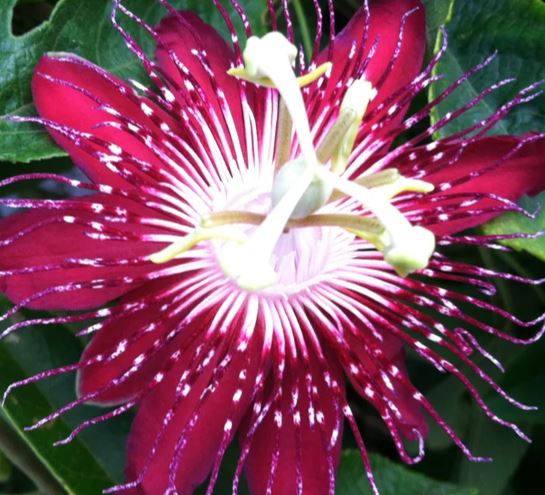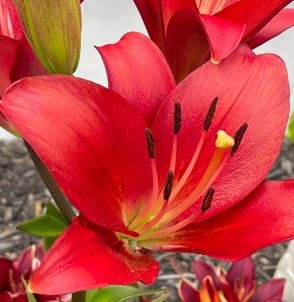
Guide to LAdy Margaret Vine
Lady Margaret
The Lady Margaret passion flower vine, scientifically known as Passiflora ‘Lady Margaret,’ is a beautiful flowering vine that belongs to the Passifloraceae family. It is a hybrid cultivar created by crossing different species of passion flowers, resulting in unique characteristics.
The Lady Margaret passion flower vine is known for its stunning flowers, which feature deep red to burgundy petals. The intricate blooms typically measure around 4 to 5 inches (10 to 12 cm) in diameter and have a prominent central structure called the corona. The corona consists of a ring of filaments and an array of colorful, thread-like structures that create a striking contrast against the dark petals.
Like other passion flower vines, Lady Margaret is a vigorous climber that can grow up to 10 to 15 feet (3 to 4.5 meters) in height. It produces tendrils that allow it to attach to trellises, fences, or other support structures. The vine has attractive, deep green foliage with deeply lobed leaves that add to its overall ornamental appeal.
In terms of cultivation, Lady Margaret passion flower vine prefers a sunny location with well-draining soil. It is generally hardy in USDA hardiness zones 9 to 11, which means it can tolerate mild winter conditions. In cooler climates, it can be grown in containers and brought indoors during the winter months.
Lady Margaret passion flower vine is known to attract butterflies and other pollinators with its nectar-rich flowers. It can be a great addition to butterfly gardens, tropical-themed landscapes, or as a focal point in a garden bed or container planting.
Care Guide for Lady Margaret Vine
1. Planting:
– Choose a location that receives at least six hours of direct sunlight daily.
– Ensure well-draining soil that is rich in organic matter.
– Dig a hole twice the size of the plant’s root ball, and gently place the vine into it.
– Backfill the hole with soil, making sure the plant is secure and upright.
2. Watering:
– Lady Margaret Passion Flower Vine prefers consistently moist soil.
– Water the plant deeply once or twice a week, especially during dry spells.
– Avoid overwatering, as it can lead to root rot.
– Mulching around the base of the plant helps retain moisture and regulate soil temperature.
3. Fertilizing:
– Feed the vine with a balanced fertilizer formulated for flowering plants.
– Apply the fertilizer according to the instructions on the packaging.
– Begin fertilizing in early spring and continue every four to six weeks until late summer.
– Avoid excessive use of nitrogen-rich fertilizers, as they can promote leaf growth at the expense of flowers.
4. Pruning:
– Prune Lady Margaret Passion Flower Vine in late winter or early spring before new growth appears.
– Remove dead or diseased branches.
– Cut back overgrown or tangled stems to maintain a tidy appearance.
– Trim the vine to control its size and shape, if desired.
5. Support and Training:
– Provide a sturdy trellis or support structure for the vine to climb.
– Gently tie the vines to the support as they grow, using soft garden twine.
– Regularly check the ties to prevent them from becoming too tight and causing damage.
– Train the vines in the desired direction, encouraging them to cover the support evenly.
6. Pest and Disease Control:
– Lady Margaret Passion Flower Vine is generally resistant to pests and diseases.
– However, keep an eye out for aphids, spider mites, and whiteflies.
– If infestations occur, use insecticidal soap or horticultural oil to control them.
– Inspect the plant regularly for signs of disease, such as leaf spots or wilting, and take appropriate action as needed.
How long does it take for this vine to produce flower
The time it takes for a Lady Margaret Passion Flower Vine to produce flowers can vary depending on various factors such as growing conditions, age of the plant, and care provided. Generally, it takes about one to two years for the vine to become established and start flowering.
Once the vine is well-established, it can produce flowers throughout the growing season, typically from late spring to early fall. However, the exact timing and duration of flowering can also vary based on climate and geographic location.
It’s important to note that passion flower vines, including Lady Margaret, often undergo a period of dormancy during winter in colder regions. During this time, they may lose their leaves and cease flowering. When spring arrives, and the growing conditions improve, the vine will resume its growth and flower production.
To encourage more abundant flowering, provide optimal growing conditions, such as ample sunlight, proper watering, and regular fertilization. Pruning the vine in early spring can also promote new growth and flowering. With proper care and favorable conditions, the Lady Margaret Passion Flower Vine can produce a profusion of beautiful flowers.





